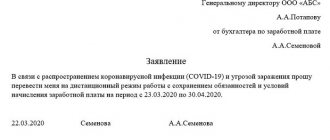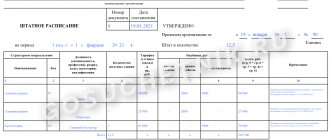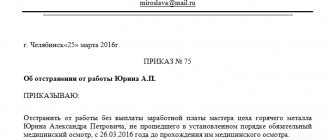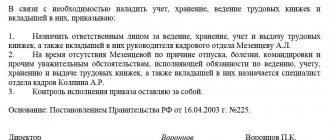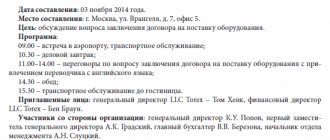When you need an order for personnel
Based on the norms of the Labor Code of the Russian Federation, we can conclude that the employer is obliged to register all personnel issues in its administrative acts and orders:
- hiring (Article 68 of the Labor Code of the Russian Federation);
- transfer to another job or position (Article 62 of the Labor Code of the Russian Federation);
- termination of the employment agreement (Article 84.1 of the Labor Code of the Russian Federation);
- provision of planned leave or recall from leave (Article 116 of the Labor Code of the Russian Federation);
- going on a business trip (Article 166 of the Labor Code of the Russian Federation);
- encouragement or disciplinary action against an employee (Article 193 of the Labor Code of the Russian Federation).
The corresponding orders are the primary accounting documents in the field of labor for the further maintenance of work books, employee cards, and their personal files. Personnel department employees prepare orders, but they are signed exclusively by managers.
Download samples
Next, we will consider orders for core activities - samples of 2020.
| On the protection of trade secrets |
| On the appointment of a person responsible for conducting labor safety briefings |
| On the appointment of a person responsible for ensuring fire safety |
| On granting the right to sign |
| About taking on the position of director |
| About creating a branch |
| On the appointment of a person responsible for maintaining work records |
| On the appointment of a person responsible for maintaining personnel records |
| On the appointment of a person responsible for maintaining time sheets |
| About staff reduction |
| About the inventory results |
How are orders for personnel drawn up?
At one time, officials developed unified forms for personnel documents, including orders. Since 2013, the authorities have abandoned the mandatory use of them. That is, employers are not obliged, but can use the proposed sample orders. All order forms necessary for personnel officers are available in Resolution of the State Statistics Committee of Russia dated January 5, 2004 No. 1. The table indicates the document numbers for further use in work. In parentheses - data on the forms used when issuing one order for several employees.
| Name of the document, order | Form number |
| About hiring | T-1 (T-1a) |
| About transfer to another job | T-5 (T-5a) |
| About granting leave | T-6 (T-6a) |
| On termination of an employment contract | T-8 (T-8a) |
| About sending an employee on a business trip | T-9 (T-9a) |
| About employee incentives | T-11 (T-11a) |
If the organization provides for the preparation of orders according to unified forms, the original details cannot be changed in them, only new ones can be added. For example, expand the lines, clarify information about the persons validating the order. If the local regulations of the enterprise stipulate other samples, then the rules for supplementing them must also be indicated.
An example of an employment order based on a unified form
Sample order for personnel in text format
Contractual relations and personnel documents
The sphere of entrepreneurship, no matter what direction it is represented, is always characterized by a variety of contracts and agreements. Some contracts have a strictly established form, others are drawn up in any form, but in compliance with certain rules. The main purpose of the document is to regulate the rights and obligations of the parties, so as not to leave room for illegal actions.
A separate section of office work is HR documents, presented in a wide variety. For them, norms and standards provide for separate procedures and periods of storage and registration. All of them, from characteristics to orders on incentives/penalties and work record books, constitute the employee’s personal file. Many of the personnel documents are compiled according to standard templates.
Other types of orders for personnel
There are other types of orders for personnel. We give only an approximate list of their enlarged groups:
- hiring, dismissal, transfer belong to the group of organizational orders for personnel;
- disciplinary orders: punishment or reward;
- regulatory: about various types of vacations, about sending on a business trip;
- salary: on the establishment of salaries, a system of bonuses and various additional payments;
- motivating: on the use of bonuses and other additional rewards;
- of a technical nature: to change, clarify or cancel an order if necessary.
Each subsequent group of orders in the list differs from the previous one, but they all regulate the interaction of the employer with the staff of employees, individually with each employee or with their groups.
Example of a disciplinary order
Orders with instructions
If necessary, an instruction is introduced into the text of the order about entrusting the execution of the order to a specific employee, as a rule, an official who is the head of the department, whose jurisdiction includes the actions necessary to execute the order.
In this case, the full name of the official and the period within which he must carry out the order are indicated.
An order may also assign control over the execution of the order to a specific official. If the text of the order does not contain notifications about the assignment of control responsibilities, this means that control will be carried out personally by the manager, so there is no need to burden the order with wording like “control over execution remains with the manager.”
Making changes to an order
Amendments and adjustments to an already officially issued order can be made on the basis of another order. In such an order it is necessary to indicate the reason for the changes, it is necessary to indicate the order to which the changes are made, and the consequences of the changes. It is mandatory for the employee to become familiar with such acts.
Adjustments are most often made as a result of:
- changes in current legislation;
- changes in circumstances that are relevant for the execution of the order, for example, changes in the circumstances of place and time;
- changes in the initial personal circumstances of the employee in respect of whom the administrative act is issued.
Thus, amendments are necessary if circumstances or the legal basis have changed, and in its current form the order is irrelevant and does not achieve the goal set when it was drafted.
Order for employment (form T-1 and T-1a)
Home / Personnel documents
| Table of contents: 1. Is it necessary to use these forms? 2. Grounds for issuing the order 3. Instructions for filling out the T-1 form 4. Sample of filling out form T-1 | 5. Instructions for filling out form T-1a 6. Sample of filling out form T-1a 7. Duration and place of storage of the document |
The employment order is included in the package of documents that are drawn up when concluding an employment contract with an employee.
This is the main document that confirms the hiring of a new employee, primarily for the accounting department, because the employment contract is kept by the personnel officer and is not a document for general use, since it may contain confidential information or a trade secret.
To register the admission of new employees in personnel records, unified forms are most often used: T-1 and T-1a. T-1 is intended to register one employee, and T-1a is used if it is necessary to register 2 or more employees.
Download form T-1 or form T-1a
Download a sample of filling out form T-1 or form T-1a
Is it necessary to use these forms?
Currently, it is not necessary to use unified forms. The legislation allows you to develop your own forms. But at the same time, it is necessary that the new form contains all the mandatory data that is written in the unified form T-1 or T-1a.
Grounds for issuing an order
The basis for the employment order is the employment contract. Not an application for employment, but a formalized and signed employment contract.
Briefly, the hiring procedure is as follows:
- Writing an application by a future employee
- Familiarization with all documents relating to job responsibilities and work of the company;
- Registration and signing of an employment contract;
- Making an order;
- Registration of a personal file, which includes copies of the employee’s documents, an employment contract, a copy of the employment order and a personal card in the T-2 form.
Thus, we can conclude that the employment order is not the main document for formalizing labor relations, but its preparation is a mandatory step. After the order is issued, its original remains in the personnel order book, and its copies are used for the following purposes:
- Submitted to the accounting department to include the employee in payroll;
- To the head of the structural unit to which the employee is hired, to inform and enter it into the work time sheet.
- In the employee's personal file.
Instructions for filling out the T-1 form
Form T-1 is intended for registration of one employee. The procedure for filling it out is as follows:
Name of company
It should be included here in full, without abbreviations. It is allowed to enter an abbreviated name (if available) in brackets, as in the constituent documents. This procedure is established by Decree of the State Standard of the Russian Federation dated March 3, 2003 No. 65-Art.
The above document is valid only until 07/01/2018, and then GOST R 7.0.97-2016 will come into force, but it also contains the same requirement regarding the name as a document requisite.
All the above rules fully apply to individual entrepreneurs.
OKPO code
Next to the name there is a small field reserved for OKPO; the data for filling it out is taken from the list of codes issued by statistical authorities when registering a company. But leaving this field empty will not be a serious mistake.
“Get Hired” field
Next to this field there are two lines: the top one indicates the date from which the employee began working for the company. The lower one is filled out only if the end date of the employment relationship is known, that is, a fixed-term contract has been concluded with the employee (temporary to replace an absent employee, to perform seasonal work).
But even in this case, it is not always possible to fill out this line, since a fixed-term employment contract can be concluded before the occurrence of a certain event, and not until a specific date. Therefore, if the exact end date of the work is unknown, then the second line remains empty.
Next, the employee’s last name, first name and patronymic in full, in the genitive case.
Personnel Number
This is an individual employee code in a given organization, which is assigned upon hiring. Since the mandatory assignment of personnel numbers is not provided for by current legislation, this field is filled in only if it is available.
Structural subdivision
If the organization does not have one, then this line remains empty.
Employee position
The job title must be entered exactly as in the employment contract and staffing table, without abbreviations.
Conditions of employment
Here marks are made about the nature and conditions of work, that is, the term (temporary, permanent) and type (main place of work, part-time work) of the employment contract. A note is also made here about the number of bets, if it differs from one.
For example, if the new job is the main one, and the contract is indefinite, then the following entry will be made: “for an indefinite period, at the main place of work.”
Payment information
These are lines intended for entering information about the employee’s salary. The nature of their design assumes that certain figures will be entered, but in practice this is not always possible, since the employee may be set piecework wages or a tariff for a certain time, and allowances are most often expressed as a percentage.
In this case, you can indicate the type of remuneration and make a link to the document in which it is described in detail, or copy during this period the procedure for remuneration as it is described in the employment contract. In any case, you must fill it out.
- The next line states the probationary period established for a particular employee;
- Basis for the order: as mentioned above, the employment contract serves as such a basis, and therefore its date and number are indicated here.
- After filling out all the data, the order is signed by the head of the organization (or individual entrepreneur);
- The final stage of issuing an order is familiarization with the employee, who signs and dates it.
You can copy an order for accounting and other departments without the employee’s signature. The document will have legal force after it has been signed by the manager. But for a personal file, it is still better to make a copy after the employee has reviewed it.
Sample filling T-1
Instructions for filling out form T-1a
The form with the letter “a” differs from the previous one in that its main part is presented in the form of a table and involves registration of the reception of several people at once, and they do not necessarily have to be received on the same day.
The order details are filled out similarly to the T-1 form. If the order is generated in the program, they will be entered automatically.
The procedure for filling out the tabular part of form T-1a:
- Last name, first name and patronymic - entered in full.
- Personnel number - when used.
- Structural unit - if available.
- Position – full name identical to that specified in the employment contract.
- Tariff rate (salary) - the procedure for filling out is similar to the T-1 form.
- Reason – two separate columns are provided for the number and date of the employment contract.
- The work period is divided into two columns: the first contains the date of acceptance, the second is filled in only if the contract is fixed-term.
- The probationary period is in accordance with the employment contract.
- Employee signature and date of review.
- Manager's signature.
This way you can add as many employees as you like. But, although the same reception date is not a mandatory requirement, it is worth remembering that the law gives only 3 days to register each employee. This period is established by Art. 67, 68 Labor Code of the Russian Federation.
In practice, this means that after the future employee has written an application for employment and has been familiarized with all local regulatory documents, the employer actually allows him to work, and the employment contract and order must be drawn up no later than 3 days later.
Sample filling T-1a
Duration and place of storage of employment orders
The original employment order is stored in the order book until the end of the calendar year in which it was issued. At the end of the year, the book is properly bound and sent for storage to the organization’s archives.
Employment orders must be kept for 75 years and in the event of liquidation of the company they must be transferred to the state archive.
Read in more detail: Order for employment
Did you like the article? Share on social media networks:
- Related Posts
- Employee's personal account (form T-54)
- Order to dismiss an employee (form T-8 and T-8a)
- Note-calculation on granting leave
- Sample of filling out form T-10
- Sample of filling out form T-7
- Sample of filling out a time sheet
- Sample of filling out form T-61
- Calculation note upon dismissal (form T-61)
Leave a comment Cancel reply
Canceling an order
Cancellation of an order regarding personnel is carried out on the basis of a management decision by a separate administrative act. In the order of cancellation, similar to the act of making amendments, it is necessary to indicate the basis for the cancellation and a reference to the order being canceled, subsequent changes in legal relations, and actions that need to be taken. The administrative act must also be made available for review to the employee whose rights and interests it affects.
Cancellation of an administrative act may become necessary due to a change in the initial circumstances under which the original order was adopted. In the activities of business entities, such cases arise quite often.
Most often, the following administrative acts need to be cancelled:
- about hiring;
- on termination of employment relations at the initiative of the employee or employer (for example, if it turns out that the reason for violation of labor duties or labor regulations is valid);
- about sending on a business trip;
- on the provision of the next paid leave;
- on early termination of a disciplinary sanction.
Orders in an organization: types and design features
5. Preparation and execution of orders 5.1. Orders formalize decisions on operational, organizational, personnel, administrative, economic and other issues of the internal work of Skala LLC (hereinafter referred to as the Company).
5.2. Draft orders are prepared by the Company's structural divisions both on the basis of instructions from the General Director and on their own initiative. Draft orders on personnel issues are prepared by the Company's HR department based on relevant submissions.
5.3. Orders are signed by the General Director of the Company, and in his absence - by the person replacing him. In the case of a proactive submission of a draft order, it is accompanied by a certificate that contains a brief summary of the essence of the order, the rationale for its necessity, as well as information on the basis on which the draft was prepared and with whom it was agreed.
5.4. Draft orders are printed on the established forms (Appendix 1) in two copies.
5.5. The order has the following details: name of the organization; type of document (ORDER), date, registration number, place of compilation (publication) of the document, title to the text, text, signature of the official, approval visas, note about the executor.
5.5.1. The title to the text of the order must briefly and accurately reflect the content of the text of the order. There is no period at the end of the title.
5.5.2. The text of the order is separated from the title by 2-3 line spacing and aligned along the left and right borders of the text field. The first line of a paragraph begins 1.25 cm from the left edge of the text field.
5.5.3. The text of the order consists of two parts: stating (preamble) and administrative.
The ascertaining part briefly outlines the goals and objectives, facts and events that served as the basis for issuing the order. It may begin with the words “for the purpose”, “in pursuance”, etc. If the order is issued on the basis of another document, then the ascertaining part indicates the name of this document, the name of the body that issued the document, the date, registration number and title to the text.
The preamble is separated from the administrative part by the word “I order”, which is written on a new line in capital letters. It is followed by a colon.
The administrative part of the order contains instructions indicating the executor(s) and deadlines for execution.
The administrative part of the order is divided into paragraphs and subparagraphs, which are numbered in Arabic numerals. One item must correspond to one instruction. Actions of a similar nature can be listed in one paragraph. Structural divisions of the Company or specific officials are indicated as performers. The last paragraph of the administrative part contains information about the official who is entrusted with monitoring the execution of the order.
If an order changes, cancels or supplements a previously issued document or some of its provisions, then one of the paragraphs of the administrative part of the text must contain a link to the document being canceled (document clause) indicating its date, number and title. The text of the paragraph begins with the words “Recognize as invalid...”.
5.5.4. Visas include the positions of the visa person, personal signatures, transcript of signatures and date. Visas are affixed on the back of the last sheet of the order or on a separate approval (endorsement) sheet.
5.5.5. The signature consists of the title of the position of the person who signed the document, a personal signature and a transcript of the signature (initials, surname). The job title is printed from the left border of the text field, the initials and surname are printed from the right border of the text field.
5.5.6. The mark about the executor includes the initials and surname of the executor of the document and his internal four-digit phone number. The executor's mark is located on the reverse side of the last sheet of the document in the lower left corner.
5.6. The divisions (officials) to whose attention the order is brought are listed in the distribution index, which the executor prepares along with the draft order.
5.7. Attachments to the order are endorsed by the head of the structural unit that prepared the project. If there are several applications, they are numbered.
5.8. The order is printed in Times New Roman font. The font size for all details, except for the name of the organization and the name of the document type, is 12. The names of the organization and the type of document are typed in capital letters and aligned in the center; font size – 16, style – bold.
5.9. On the back of the last sheet of the draft order submitted for approval, the visa of the executor and the head of the structural unit that is developing this project is affixed.
5.10. All draft orders undergo legal (legal) examination by the Company’s legal service.
5.11. Draft orders affecting financial legal relations are subject to approval by the Company's accounting department.
5.12. Structural divisions review draft orders within two working days following the day they are received for legal examination or approval.
5.13. Objections and comments to the draft order are set out on the certificate attached to the draft. If fundamental changes are made to the draft order during the approval process, it is subject to reprinting and re-approval.
5.14. Making changes to the signed order, as well as to the agreed draft document, is not allowed.
5.15. Responsibility for the high-quality preparation of draft orders, their legal (legal) examination and approval lies with the heads of the Company’s structural divisions that develop the draft orders.
5.16. The office monitors the correct execution of draft orders.
5.17. Orders signed by the general director are sent to the office for registration. Orders are numbered sequentially within a calendar year. Orders on core activities, personnel and administrative and economic issues are numbered separately and assigned letter indices to the numbers:
OD – orders for core activities,
LS - orders for personnel,
AH - orders on administrative and economic issues.
Letter indices are written after the order number and are separated from it by a slash, for example: 123/OD.
The date of the order is the date of its signing.
5.18. One copy of the order is given to the executor. The second remains in the office and is placed in the file.
5.19. Responsibility for compiling an index for distributing the order to all interested parties lies with the head of the structural unit that developed the draft order. The head of the office is responsible for familiarizing interested employees with the order, according to the distribution index.
